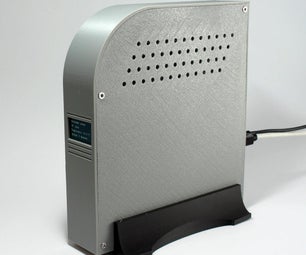Introduction: How to Make a Hoverboard
Have you ever fantasized about flying on a cool hoverboard like in Back to the Future 2? Were you ever mad that such a technology hadn't been created yet, or had been faked as a prank(yes, Back to the Future fans, I know you know what I'm talking about)? Well, wait no longer! My step by step guide will have you building an electromagnetic one in no time. However, I must disclaim, the original, design of this makes it so its not actually movable like a skateboard, but will instead float in the same place. I would suggest reading through this entire guide before making the choice to create you own. If you do create you own using this idea, but altering it for the better, I would be very happy if you would send me your work so I can see how to make mine better. I'm always excepting friendly criticism. Let's get started! (Keep in mind that this hoverboard and the one from Back to the Future will not look the same.)
Step 1: Materials: What to Get
(Keep in mind this is based on my design. Get more if you plan on building a stronger, or larger scale hoverboard)
MATERIALS:
1. (x6) 6" Iron Railroad Spike. (Could you believe all they use these for now is for antiques and knife-making faires. I don't think railroad companies even use them anymore!)
2. 300-400' enameled copper wire(AKA: Magnet Wire) 20 AWG (I would suggest Remington Industries for this)
3. Wire Strippers (duh!)
4. Duct Tape (You can never have too much duct tape)
5. 50 D Batteries. DO NOT: get power saver batteries or anything that the package says "longer lasting" this means it uses less energy than regular batteries, and you're going to need a LOT of energy. (and yes I said fifty of them, not a typo)
6. A Standard Skateboard (I would suggest Tony Hawk skateboards. That's what I based my measurements on.)(Also, make sure its one you're not afraid to dismantle)
7. A Non-Conductible Base. (Large enough to fit three skateboards side by side) DO NOT: use a floor as a base. this base is meant for maneuverability so you could take you hoverboard to test in different locations.
8. 16 small screws. (I used the screws that were already on the board(plus another board's screws). I would recommend getting iron screws that were that size if you can find them)
9. Screwdriver (Again: Duh!)
10. Electric Drill. (I'll explain later)
11. Battery Holders (Same amount as the amount of batteries your getting.)
12: Measuring Tape (For measuring. I don't think a really need to point that out do I?)
13: Hot Glue Gun (w/ hot glue sticks obviously)(yes, you need this AND the duct tape)
That's all.
Step 2: Skateboard: Preparations
This is where everything gets started. Keep in mind: When I say top of the board, I mean where you put your back foot in preparation for a kick-flip.(Research for a better understanding if needed)
Step 1: Unscrew your screws from the board. This means you'll be taking off the plates and wheels. This should leave you with eight holes.
Step 2: Using your electric drill, drill the holes in order to increase their diameter by approximately 2 millimeters.
Step 3: Now you need to pay close attention. (on each side of the board) 2 ½” away from the edge (top and bottom) of the board and 2 ⅛” away from left of the board, drill a hole. Now drill another hole 2 ⅝” to the right of the first hole so that it is 2 ⅛” away from the right of the board. Repeat this step so that there are 2 holes at the top of the board and the bottom of the board. (As said at the beginning of the step.) Make these holes are of the exact same diameter as the board's original holes are now.
Step 3: Base: Preparation
Prepare your base on the ground or affixed in a position or manner that would enable you to go around it freely and do the required steps.
Step 1: Put the six railroad spikes to the base so that they are in the center and are spread equally 1 foot apart from each other to resemble what a six looks like on a dominoes piece. (3 by 2) Make sure the base of the spike is what's going to be attached to the actual base.
Step 2: Affix hot glue to the bottom of each of the spike bases and the actual base. Let each of them dry. You may want to hold them until they do.
Step 3: Attach a piece of duct tape so that there is only one inch of tape on each side of each railroad spike and one to several inches of the duct tape strips attached to the base. Yes, this is for support of the spikes so they don't fall, and yes, you WILL need this much support. We're dealing with electromagnets here, remember?
Step 4: Base: Actual Work
Now we're really getting started!
Step 1: (Note: Flat part=base, Pointed part=tip) From the base of the railroad spike, wrap the magnet wire around it counterclockwise while all the while attempting not to leave any space in between strands and wrapping as tightly and as close together as possible, up to the tip of the railroad spike. DO NOT: overlap. Leave about at least a foot of extra wire hanging from the end on the base, and at least two feet of extra wire on the end of the tip of the spike.
Step 2: Repeat Step 1 for all six railroad spikes. I would keep the extra feet of wire on the ends bent so they point outwards.
Step 3: Once that's done, connect 5 battery holders together. Do this 6 times, there should be one set for each spike. What I mean by connect is put it in a manner so that, if you hooked a set up to a light, the light wouldn't get 1 battery power, it would get 5 times the power of 1 battery; Hence 5 batteries per set. Put each of the batteries into the battery holders.
Step 4: Put each set next to or near the spikes, but still on the base.
Step 5: Connect the extra strand that's attached to the base of the railroad spike to the positive side of the battery set.
Step 6: Then, put the extra strand that's attached to the tip of the railroad spike close to the negative side of the battery set. DO NOT: connect it, this will cause one of the six electromagnets that you just made to turn on and waste power.
Step 7: Repeat steps 5-7 for each electromagnet.
Now you're finished with the base. All that's left to do is the board itself.
Step 5: Skateboard: Actual Work
Now were onto the actual work of the skateboard's conversion to working hoverboard! If you've been doing the steps from the beginning, that means that you're half-way there!
Step 1: (Note: Flat part=base, Pointed part=tip) Taking one of your screws and your magnet wire, wrap the magnet wire around it counterclockwise while all the while attempting not to leave any space in between strands and wrapping as tightly and as close together as possible, up to the tip of the screw. Make sure to leave about two feet of extra wire at the tip and about half a foot of extra wire at the base.
Step 2: Repeat Step 1 for all 16 screws. This might be tediously tiring so I would suggest listening to music to keep you going, especially if you're working on this late into the night.
Step 3: Now take one of the magnet wire-wrapped magnets and put it into the board so the base if facing up. (If it doesn't fit, then use the electric drill to make the holes bigger) The tip extra wire should be able to go around the board and onto the top, while the base extra wire should be resting on the top of the board.
Step 4: Repeat Step 3 for all 16 screws.
Step 5: Put the battery holding battery holders(say that five times fast) on the top of board, one for each screw, near each screw. (You didn't see that coming did you?)
Step 6: Connect the base extra wire to the positive side of the battery holder. Position the tip extra wire so it can easily be attached to the negative side of the battery holder from its position.
Step 7: Repeat Step 6 for each of the 16 screws that you have.
Now you're done with the board. I bet you're going to love the next step.
Step 6: Hoverboard: Testing, Testing, 1-2-3
If you can't tell from the title, this is the final step. You get to actually test your (hopefully) flying hoverboard! I can sense the excitement!!
DO NOT: test the hoverboard near anything mechanical, electrical, or even metal for that manner. Like I said before, the base was made to be portable. You should test this outside, in an open field, or near the highway. (That would make for some awesome pranked drivers who just happened to drive by and see a board floating. Please send me the video if you do, indeed, do that.)
Step 1: Position your finished base in the desired location.
Step 2: Attach all the wires to the desired negative sides. (DO NOT: keep you hand on the wire for too long. Those wires will heat up very fast, and could burn you. Be careful.)
Step 3: On the board, attach all the wires to their desired negative destinations. ((again)DO NOT: keep you hand on the wire for too long. Those wires will heat up very fast, and could burn you. Be careful.)
Step 4: Wait 1-2 minutes for it to warm up. After a while, you might feel a slight pull from the base to the board. Don't worry if you don't.
Step 5: Hold the board above the base, this might take some positioning for it to stay, and it will float.
Enjoy.









